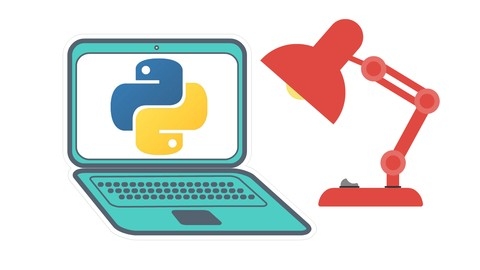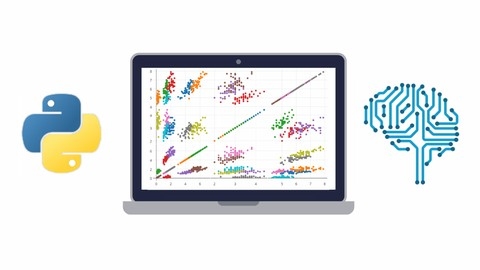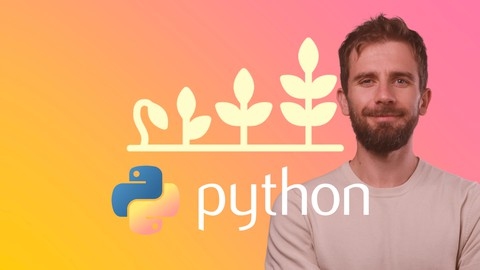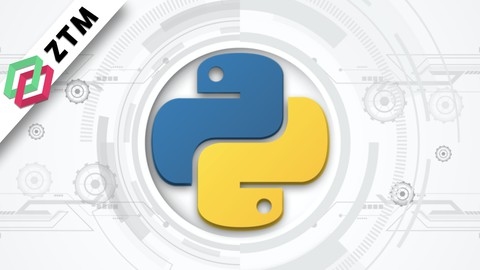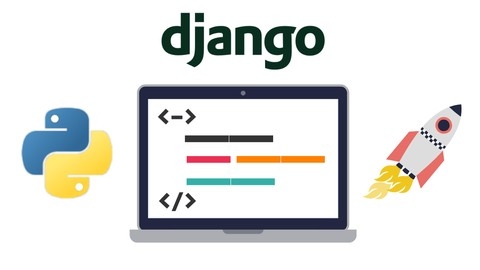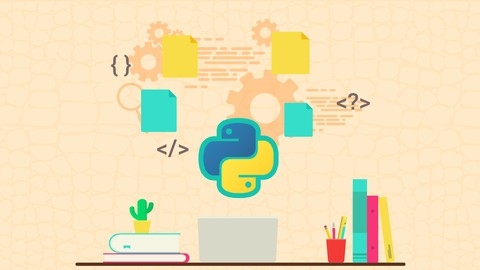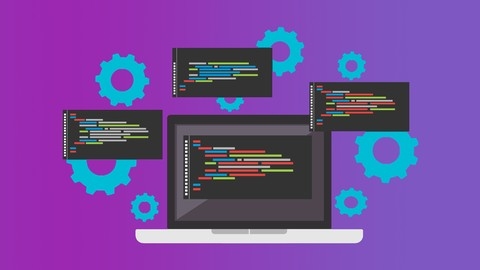The Complete Python Bootcamp From Zero to Hero in Python
You’ll start by learning why Python is a popular language and setting up your Python environment.
The course then dives into the fundamentals of Python objects and data structures like numbers, strings, lists, dictionaries, tuples, sets, and booleans.
You’ll learn how to perform operations on these data types, index and slice them, and use methods associated with them.
Next, you’ll explore control flow statements like if-else, for loops, and while loops, along with useful operators and list comprehensions.
This section teaches you how to add logic to your Python scripts.
The course then covers functions in-depth, including defining functions, using parameters, returning values, and concepts like *args and **kwargs.
You’ll also learn about lambda expressions, map and filter functions, nested statements, and scope.
Object-Oriented Programming (OOP) is a crucial topic covered, where you’ll learn about classes, objects, attributes, methods, inheritance, polymorphism, and special methods.
This will help you write more organized and reusable code.
You’ll learn how to work with modules, packages, and the Python import system, as well as error and exception handling, which is essential for writing robust code.
The course also covers unit testing with the unittest library and code analysis with Pylint.
The course includes two milestone projects where you’ll apply your knowledge to build practical applications, such as a simple user interaction program and a Blackjack game.
Advanced topics like Python decorators, generators, and built-in modules like collections, os, datetime, math, random, re (regular expressions), and time are also covered.
You’ll learn web scraping with BeautifulSoup and Requests, working with images using the Python Imaging Library, handling PDFs and CSV files, and sending and receiving emails with Python.
The course concludes with a final capstone project and a bonus section on building graphical user interfaces (GUIs) with Python.
Throughout the course, you’ll find quizzes, coding exercises, and homework assignments to reinforce your learning.
The instructor provides solutions and walkthroughs to help you understand the concepts better.
100 Days of Code: The Complete Python Pro Bootcamp
The “100 Days of Code: The Complete Python Pro Bootcamp” is your comprehensive guide to mastering Python, covering everything from basic variables and data management to advanced web development and data science.
Starting with foundational skills, you’ll quickly progress to building practical projects like a Band Name Generator and a Tip Calculator, applying your learning in real-world scenarios.
As you advance, the course introduces essential programming concepts such as control flow, logical operators, and Object-Oriented Programming (OOP), equipping you with the skills to write clean and efficient code.
Interactive coding exercises and projects, including game development and a Coffee Machine program, reinforce your understanding and keep you engaged.
Beyond coding, you’ll learn vital professional tools and techniques, including version control with Git and GitHub, debugging strategies, and API integration, preparing you for a career in tech.
The bootcamp also covers web development with Flask, teaching you to create dynamic websites and deploy them online.
Data science modules introduce you to libraries like Pandas and Matplotlib, enabling you to analyze and visualize data effectively.
By the end of the course, you’ll have a diverse portfolio of projects, showcasing your ability to tackle Python programming challenges across various domains.
Python for Data Science and Machine Learning Bootcamp
This course begins with a straightforward introduction to Python and setting up your environment with Anaconda and Jupyter Notebooks, ensuring you have the necessary tools at your disposal.
Quickly moving on, you’ll dive into Python programming through an engaging crash course.
This section equips you with the foundational skills needed for data analysis, preparing you for the more complex topics ahead.
The course then guides you through essential libraries like NumPy and Pandas, pivotal for data manipulation, followed by an in-depth exploration of data visualization tools including Matplotlib, Seaborn, and Plotly.
These segments are packed with exercises and projects, allowing you to apply what you’ve learned in practical scenarios.
When it comes to machine learning, the course covers a broad spectrum of algorithms from Linear Regression to Neural Networks, offering both theoretical knowledge and Python implementation practices.
You’ll get hands-on experience with TensorFlow and Keras in the Neural Nets and Deep Learning section, preparing you for the latest advancements in the field.
Additionally, the course introduces Big Data and Spark with Python, teaching you how to handle large datasets using Spark and AWS.
This inclusion ensures you’re well-versed in a crucial aspect of modern data science.
By the end of this course, you’ll have completed several capstone projects, each designed to challenge your understanding and application of the course material.
Automate the Boring Stuff with Python Programming
The course starts by covering the basics of Python programming.
You’ll learn how to install Python and use the IDLE interactive shell and file editor.
This will help you get familiar with basic programming terminology and writing your first Python programs.
Next, you’ll dive into flow control statements like if/else, while loops, and for loops.
These allow you to control the order in which your program executes instructions based on certain conditions.
You’ll also learn about functions - both Python’s built-in functions and how to write your own.
Error handling is crucial, so you’ll learn to use try/except statements to gracefully handle errors instead of crashing your program.
To solidify these concepts, you’ll build a complete “Guess the Number” game from scratch.
The course then covers data structures like lists and dictionaries, which allow you to store and organize multiple values.
You’ll learn about string formatting and methods too.
Once you have these fundamentals down, you’ll learn how to run Python programs from the command line instead of just IDLE.
Regular expressions are introduced - powerful patterns for finding and manipulating text.
File handling is covered in-depth, teaching you to read, write, copy, move, and delete files programmatically.
You’ll also learn debugging techniques like logging and using the debugger.
Web scraping is a major topic - downloading data from websites, parsing HTML with Beautiful Soup, and even controlling browsers with Selenium.
Working with Excel, Word, and PDF documents is also covered.
The course dives into email automation - sending and retrieving emails with Python scripts.
Finally, you’ll learn GUI automation by controlling the mouse, keyboard, and taking screenshots for image recognition.
Learn Python Programming Masterclass
The course starts with a comprehensive introduction, covering the installation and setup process for different operating systems like Windows, Mac, and Linux.
This ensures that you’re ready to dive into the world of Python programming right from the start.
One of the standout features of this course is its systematic approach to teaching Python fundamentals.
You’ll learn about printing, strings, variables, data types, operators, and expressions, which form the backbone of any programming language.
The course also covers essential concepts like program flow control using if statements, for loops, and while loops.
These topics are crucial for writing efficient and logical programs.
As you progress, you’ll delve into the world of lists and tuples, which are fundamental data structures in Python.
The course covers various operations on these structures, such as sorting, slicing, and comprehensions.
You’ll also learn about functions, a core concept in programming that allows you to modularize and reuse code.
The course then introduces you to dictionaries and sets, which are powerful data structures for storing and manipulating data.
You’ll learn how to work with files, both text and binary, including reading, writing, and parsing data in various formats like JSON and CSV.
Moving forward, you’ll explore modules and functions in Python, gaining a deeper understanding of how to organize and structure your code.
The course covers object-oriented programming (OOP) concepts like classes, inheritance, polymorphism, and encapsulation, which are essential for building robust and scalable applications.
Databases are an integral part of modern software development, and this course covers the basics of SQL and how to use databases in Python applications.
You’ll learn about SQLite, a lightweight and embedded database, and how to interact with it using Python.
The course also covers advanced topics like generators, comprehensions, and the timeit module, which can help you write more efficient and performant code.
Additionally, you’ll learn about Big O notation, which is crucial for understanding the time and space complexity of algorithms.
Throughout the course, you’ll work on practical examples and challenges, reinforcing your understanding of the concepts covered.
The instructor provides clear explanations and demonstrations, making it easier to grasp even the most complex topics.
One notable aspect of the course is its emphasis on writing clean and readable code.
You’ll learn about PEP8, the Python style guide, and how to refactor your code for better maintainability.
Python Mega Course: Learn Python in 60 Days, Build 20 Apps
The course starts with the fundamentals, teaching you how to create and run your first Python program, work with variables, functions, and data structures like lists and dictionaries.
You’ll learn about control flow statements, file handling, and modules, building a to-do app along the way.
As you progress, you’ll dive into intermediate topics like object-oriented programming (OOP), APIs, data analysis, and visualization with libraries like Pandas, Matplotlib, and Plotly.
You’ll build practical applications like a weather data API, a news email digest, and a webcam monitoring system.
The course also covers web scraping, SQL databases, and graphical user interfaces (GUIs) using PyQt.
You’ll learn how to build web applications with Flask and Django, create a movie recommendation system using machine learning, and even publish your own Python package.
Throughout the course, you’ll work on hands-on projects that reinforce the concepts you’ve learned.
The instructor provides coding exercises, quizzes, and bug-fixing challenges to help you practice and solidify your understanding.
One notable aspect of this course is its focus on real-world applications.
You’ll learn how Python is used in various industries and gain exposure to tools and concepts like version control with Git, cloud deployment, and collaborative coding.
The Complete Python Developer
The course starts with an introduction, covering the basics like what a programming language is, how to run Python code, and the differences between Python 2 and 3.
You’ll write your first program here.
Next up is the Python basics - data types like numbers, strings, booleans, lists, dictionaries, and tuples.
You’ll learn operators, conditional logic, loops, functions, and other core concepts.
This section lays the foundation for more advanced topics.
The developer environment section guides you through setting up Python on different operating systems and introduces tools like code editors, Jupyter Notebooks, and formatting standards.
Then, you dive into object-oriented programming (OOP) - creating classes, objects, inheritance, polymorphism, and more.
OOP is crucial for writing reusable, maintainable code.
Functional programming principles like pure functions, lambda expressions, and comprehensions are covered next.
You’ll learn how to write concise, readable code.
Further advanced topics include decorators for meta-programming, error handling, generators for efficient looping, and working with modules/packages.
The course explores file I/O, regular expressions, automated testing, and career advice for Python developers.
You’ll build portfolio projects using web frameworks like Flask.
Interestingly, there are sections on scripting with Python for image processing, PDF manipulation, sending emails, and building Twitter bots and SMS applications.
Web scraping using libraries like BeautifulSoup is also included.
Machine learning and data science get their own dedicated section, covering fundamentals, tools like Kaggle, and building a “smart brain” project.
Towards the end, you’ll learn Git/GitHub for version control and open-source contributions.
The course wraps up with coding challenges and productivity tips.
The Python Bible | Everything You Need to Program in Python
The course starts by introducing you to Python and guiding you through installing it on different operating systems like Windows, Mac, and Linux.
You’ll also get acquainted with IDLE, the Python IDE, and learn a top secret tip that can save you hours of time and headaches while learning on Udemy.
Next, you’ll dive into the fundamentals of Python programming.
You’ll learn about variables, numbers (including arithmetic operations, floats, and modulo), and strings (concatenation, formatting, slicing).
These concepts are reinforced through practical projects like creating a health potion for a video game, building a “Hello You!” program, and making an email slicer.
The course then covers essential programming concepts like conditional logic (if statements, boolean values, comparison operators), data structures (lists, tuples, dictionaries), and loops (while and for loops).
You’ll apply these skills to build fun projects like a ridiculous security system named Travis, a cinema simulator, and even a Pig Latin translator!
Once you’ve grasped the basics, you’ll level up by learning how to create your own functions in Python, including understanding variable scope, keyword arguments, and packing/unpacking using *args and **kwargs.
You’ll put these skills into practice by developing a Tic Tac Toe game.
The course also introduces you to object-oriented programming (OOP) in Python.
You’ll learn about classes, objects, inheritance, and build projects like creating different coin objects and even your own bank with current and savings accounts.
Throughout the course, you’ll find quizzes and coding challenges to reinforce your understanding, as well as resources like the complete source code used in the lectures.
Python and Django Full Stack Web Developer Bootcamp
The course starts by covering the fundamentals of front-end web development, including HTML, CSS, Bootstrap, JavaScript, jQuery, and the Document Object Model (DOM) for creating interactive websites.
Then it dives into Python programming, teaching you the basics like numbers, strings, lists, dictionaries, tuples, sets, booleans, control flow, and functions.
It also covers more advanced Python concepts like Object Oriented Programming (OOP), errors and exceptions, regular expressions, modules, and decorators.
Once you have a solid grasp of Python, the course introduces the Django web framework.
You’ll learn how to create Django projects and applications, work with models, templates, views, URL mappings, and static files.
It covers forms for accepting user input, model forms, and form validation.
The course goes beyond the basics by teaching you how to customize Django templates using template inheritance and custom filters.
You’ll also learn about user authentication, passwords, and deploying your Django projects to production using services like PythonAnywhere and GitHub.
Additionally, the course covers advanced topics like Class-Based Views (CBVs) for more efficient coding and customizing the Django admin interface.
There are two major projects where you’ll build a blog site and a social media clone from scratch, applying everything you’ve learned.
Python for Beginners: Learn Python Programming (Python 3)
The course begins with an overview and provides the necessary downloads, including solutions to practice exercises.
It guides you through setting up Python on different operating systems like Windows, Mac, and Linux.
You’ll learn how to write and run Python programs right from the start.
The course dives into strings, variables, functions, and printing, teaching you string methods, concatenation, and formatting.
After a quiz and practice exercises, it moves on to numbers, math operations, numeric functions, and comments.
Booleans and conditionals are covered next, allowing you to control program flow.
Functions are explored in-depth, covering function creation, parameters, and return values.
The course then introduces lists, a crucial data type, teaching you how to create, manipulate, search, slice, and loop through lists.
Exception handling and sorting are also included.
Dictionaries and tuples, two more essential data types, are explained with their creation, access, and manipulation.
Working with files is a vital skill, and the course covers opening, reading, writing, and handling exceptions when dealing with files.
Modules are introduced, enabling you to import and use external code in your programs.
Finally, a bonus lecture promises secret content, adding an element of intrigue.
The course follows a structured approach, with each section providing an overview, lectures, quizzes, practice exercises, and detailed solutions.
Python for Absolute Beginners
You’ll begin by installing Python and the Pycharm IDE, setting up your first project.
The course then dives into Python basics - variables, data types, math operators, and printing to the console.
You’ll learn how to work with strings, including escape sequences and string methods.
Along the way, you’ll tackle programming challenges like creating an asterisk triangle and implementing the famous Fizz Buzz problem.
Once you have the fundamentals down, the course moves on to functions - defining them, passing parameters, and working with modules.
You’ll build programs to calculate the volume of a rectangular prism, convert temperatures between Celsius and Fahrenheit, and find a vehicle’s miles per gallon.
Flow control is crucial in programming, so you’ll learn about comparison and boolean operators, if/else statements, and truthy/falsey values.
You’ll create a grade determiner program and convert numbers to their Roman numeral equivalent.
The syllabus covers loops in-depth - while and for loops, the range() function, and applying loops to solve problems like finding the sum of numbers, counting string characters, and calculating factorials.
You’ll continue exploring strings, lists, dictionaries, tuples, and sets.
Expect plenty of exercises on methods for each data structure.
Some highlights include building a string reverser, word counter, and working with dictionary methods like .keys(), .values(), and .update().
Throughout, you’ll be challenged with programming exercises to reinforce concepts.
The course is comprehensive for beginners, covering core Python skills needed for more advanced topics.
The Modern Python 3 Bootcamp
The course starts with the fundamentals, guiding you through setting up Python on your machine (Windows or MacOS) and introducing you to the command line.
It then dives into core Python concepts like numbers, operators, strings, variables, and data types, ensuring you have a solid foundation.
You’ll learn about control flow statements like if-else and loops, which are essential for writing programs that make decisions and repeat tasks.
The course also covers data structures like lists, dictionaries, tuples, and sets, teaching you how to store and manipulate data effectively.
Functions are a crucial part of any programming language, and the course dedicates several sections to them, covering topics like parameters, arguments, scope, and decorators.
You’ll also learn about lambda functions and built-in Python functions like map, filter, and reduce.
Error handling and debugging are essential skills for any programmer, and the course covers them in-depth, teaching you how to handle exceptions and use tools like pdb for debugging.
The course then moves on to more advanced topics like modules, which allow you to organize and reuse code.
You’ll learn how to work with built-in modules and create your custom modules, as well as how to install and use external modules like termcolor and autopep8.
Object-Oriented Programming (OOP) is a fundamental concept in Python, and the course dedicates several sections to it, covering classes, objects, inheritance, polymorphism, and more.
You’ll also work on a practical project, building a deck of cards using OOP principles.
The course covers iterators and generators, which are powerful tools for working with sequences and creating efficient code.
You’ll learn how to write custom iterators and generators, as well as how to use generator expressions.
Web scraping is a valuable skill, and the course teaches you how to use the BeautifulSoup library to extract data from websites.
You’ll work on a project to scrape quotes from a website and save them to a CSV file.
Regular expressions are a powerful tool for working with text, and the course covers them in detail, teaching you how to write and use regular expressions in Python.
The course also covers working with databases, specifically SQLite3, teaching you how to create tables, insert data, and query databases using Python.
Throughout the course, you’ll work on numerous exercises and projects to reinforce your understanding of the concepts.
The exercises range from simple tasks to more complex challenges, ensuring you gain practical experience.
